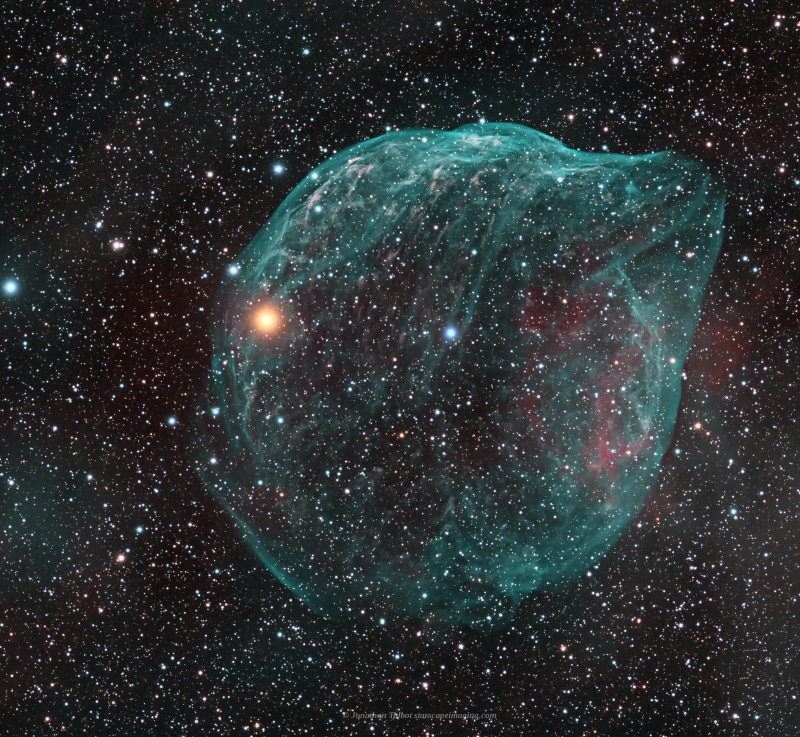A huge bubble in the southern sky, Sh2-308, The Dolphin Nebula
Published 18 March 2021
About this object
Sh2-308 is also known as the Dolphin Nebula. It's located in the southern constellation Canis Major. Its a huge bubble of gas, mostly double ionized oxygen, caused by strong winds from a hot, massive Wolf-Rayet star called HD 50896 (near center). Wolf-Rayet stars are typically 20 times the mass of the sun. Sh2-308 lies 5,200 light years distant and is 60 light years in diameter. There is also some red Hydrogen emission as seen on the right side and in the whiteish red streamers near the top of the nebula.
The Dolphin nebula is rather low at -23 deg declination, and from my location and setup, I only had a few hours per night to collect data for the image. I was able to gather a bit each imaging session from Nov 20 thru mid March 21 to reach the point where I felt I had enough to produce the image above. The image is a HOO image with Hydrogen mapped to red and doubly ionized Oxygen to green and blue. I also added in RGB stars. An interesting and often overlooked object is right near the bottom center of the nebula. Its a round and faint planetary nebula called PN G234.9-09.7 and is 2.3 arc min in size. A fair amount of faint galaxies are also in the image. To see where all these objects are, click here for an annotated image.
Sh2-308 is also known as the Dolphin Nebula. It's located in the southern constellation Canis Major. Its a huge bubble of gas, mostly double ionized oxygen, caused by strong winds from a hot, massive Wolf-Rayet star called HD 50896 (near center). Wolf-Rayet stars are typically 20 times the mass of the sun. Sh2-308 lies 5,200 light years distant and is 60 light years in diameter. There is also some red Hydrogen emission as seen on the right side and in the whiteish red streamers near the top of the nebula.
The Dolphin nebula is rather low at -23 deg declination, and from my location and setup, I only had a few hours per night to collect data for the image. I was able to gather a bit each imaging session from Nov 20 thru mid March 21 to reach the point where I felt I had enough to produce the image above. The image is a HOO image with Hydrogen mapped to red and doubly ionized Oxygen to green and blue. I also added in RGB stars. An interesting and often overlooked object is right near the bottom center of the nebula. Its a round and faint planetary nebula called PN G234.9-09.7 and is 2.3 arc min in size. A fair amount of faint galaxies are also in the image. To see where all these objects are, click here for an annotated image.
Image Details
- Optics : STELLARVUE SVX 152T refractor @f8 1200mm FL
- Mount: Paramount MYT
- Camera: ZWO ASI6200
- Filters: Chroma 50mm LRGB
- Exposure (min): RGBHaOIII 125:125:125:540:580 24.9 hrs, 2x2 binning
- Camera/Mount Control: The Sky X, Voyager
- Guiding: StarlightXpress Lodestar X2
- Processing: PixInsight 1.8,
- Location: Stark Bayou Observatory, Ocean Springs, MS
- Sky: Typical SQM 19.6-20.1, Bortle 5, Suburban
- Date: 23 Nov 20 - 12 March 21







